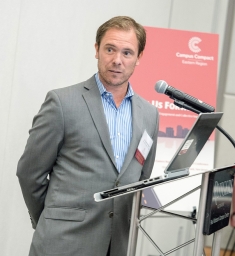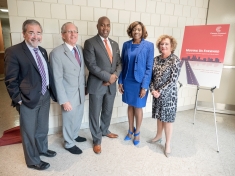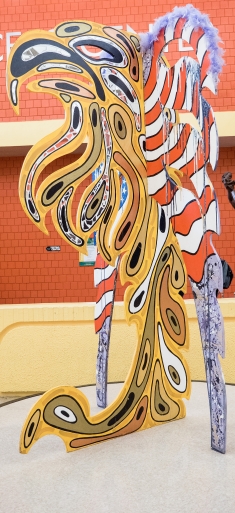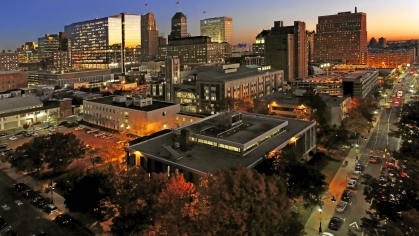Campus Compact’s Fifth Annual Eastern Region Conference Hosted at RU-N, NJIT, and ECC
On October 14-16, 2015, Campus Compact convened its Fifth Annual Eastern Region Conference, “Moving Us Forward: At the Intersection of Community Engagement and Collective Impact,” on the campuses of Rutgers University-Newark (RU-N), New Jersey Institute of Technology (NJIT), and Essex County College (ECC).
Campus Compact is a national coalition of nearly 1,100 colleges and universities committed to the public purposes of higher education. As the only national higher education association dedicated solely to campus-based civic engagement, Campus Compact enables campuses to develop students’ citizenship skills and forge effective community partnerships. Its resources support faculty and staff as they pursue community-based teaching and scholarship in the service of positive change.

In envisioning a conference that would take place over three days at three neighboring higher education institutions anchored in an urban environment, conference chair and executive director of New Jersey Campus Compact, Dr. Saul Petersen, noted, “In its very DNA, this conference needed to embody the antithesis of competition and the power and possibility of true collaboration when breaking new ground.” Accordingly, Petersen acknowledged the unprecedented role RU-N’s Office of University-Community Partnerships played in bringing together seamlessly more than 30 students and staff volunteers from each of the three institutions to ensure the success of the conference, serving as an instructive model for other institutions and future Campus Compact conferences. As a result of such mutual cooperation, more than 200 professionals, scholars, and community leaders gathered at this year’s Eastern Region Conference to exchange ideas and share best practices on how to utilize effectively the collective resources and assets of postsecondary institutions, community-based organizations, and municipalities to promote an engaged citizenry to ultimately help communities tackle deeply entrenched and complex social problems.
Recognizing that “collective impact” is an innovative and structured approach to making collaborations work across multiple constituencies to achieve significant and lasting social change, the conference agenda covered a variety of topics of interest to practitioners, scholars, officials, and administrators alike. Conferees’ choices included workshops and institutes on creating a college-readiness pipeline, fostering service learning alliances, developing work-readiness programs, exploring strategic partnerships between philanthropies and postsecondary institutions, understanding the impact of engagement through digital influences, and promoting student achievement through transformative teaching practices.

The conference culminated with a presidential panel that included representatives of the Newark City of Learning Collaborative (NCLC): The Honorable Ras Baraka, mayor of the City of Newark; Dr. Joel Bloom, president of NJIT; Dr. Nancy Cantor, chancellor of RU-N; Dr. Gale Gibson, president of ECC; and Dr. Brian Strom, chancellor of Rutgers Biomedical Health Sciences (RBHS). Andrew Seligsohn, president of Campus Compact, served as moderator.
NCLC is a citywide, multi-sector network of more than 60 institutions charged with increasing by 2025 the number of Newark residents with postsecondary degrees. Specifically, the goal is to progress from 17 percent of the city’s current population (29,000 individuals) to 25 percent (50,000 individuals, accounting for projected growth of Newark’s population). The panelists attributed the success of NCLC to the synergistic relationships of its members. For the institutions represented on the panel, very little competition exists among them. For example, ECC creates a pipeline of college-ready students for RU-N and NJIT, RU-N and NJIT have co-curricular programs and joint hires, and many RU-N and NJIT alumni pursue their graduate studies at RBHS. Moreover, Newark benefits economically when college students spend more time in the city as residents, employees, and patrons.
One of the conference’s institutes afforded some attendees the opportunity to examine another successful Newark collective impact program, Newark Fairmount Promise Neighborhood (NFPN), and take a bus tour of the community. NFPN is managed collaboratively by RU-N’s Office of University-Community Partnerships, the United Way of Essex and West Hudson, and the Urban League of Essex County, in collaboration with Newark Public Schools. NFPN unites residents with public and private partners to develop, deliver, and monitor a continuum of high-quality programs and supportive services for children in one of New Jersey’s most challenged communities.
“NCLC and NFPN sharply reflect the ways that anchor institutions in Newark are collaborating to take on some of the city’s most pressing challenges,” said Chancellor Cantor. “And that work resonates powerfully across the country and the world because expanding educational access and opportunity and building safer, healthier, and stronger neighborhoods are some of the most pressing challenges facing metropolitan America and metros everywhere.”

Perhaps the most endearing example of community collaboration shared at the conference was the exhibition of several Animodule contemporary art sculptures. Dubbed “Newark’s Official Peace Ambassadors,” the Animodules project is an initiative of the Barat Foundation, a nonprofit educational organization dedicated to expanding creative opportunities through immersion programs designed to maximize artistic and intellectual achievement and personal growth. Facilitated by artists in residence, more than 50 Animodules have been created through the collaborative efforts of schools and youth groups. Each structure represents the work of 20-150 children and brings 20-60 hours of arts education to underserved youths. Animodules march each year in Newark’s Creation Nation Art and Peace Parade, founded in 2008, and welcome more than 500,000 international travelers annually at the Newark Liberty International Airport.
“Campus Compact works to ensure that community engagement is a visible expression of the cultural values found in higher education, and that this expression is seen to be both inclusive and empowering,” said Saul. “Based on preliminary feedback from conference attendees, the overarching theme, individual presentations, featured speakers, and informal conversations succeeded in establishing its intended target, that is, when higher education plays a sustained but evolving role in large-scale collaboratives, then community-wide transformation can be a realistic goal.”
As Seligsohn observed, "The Eastern Region Campus Compact Conference in Newark was a major success. Those of us in attendance not only learned a great deal about how to advance collective impact initiatives in our communities but also had the opportunity to experience firsthand three institutions working to change the educational opportunity landscape in the city of Newark. Campus Compact exists to help our member institutions continue to get better at supporting positive change, and this conference was a terrific example of our mission in practice."
PHOTOS:
(Photo, top center: Rutgers University-Newark; photo credit: Arthur Paxton)
(Photo, top right: Dr. Saul Petersen; photo credit: Shelley Kusnetz)
(Photo, bottom right (l-r): Dr. Brian Strom, Dr. Joel Bloom, The Honorable Ras Baraka, Dr. Gale Gibson, Dr. Nancy Cantor; photo credit: Shelley Kusnetz)
(Photo, bottom left: one of several Animodule art structures on display; photo credit: Shelley Kusnetz)

